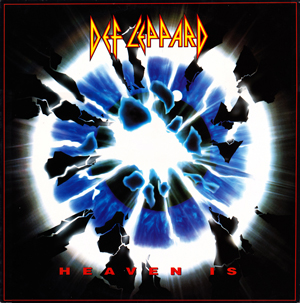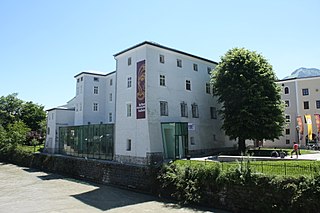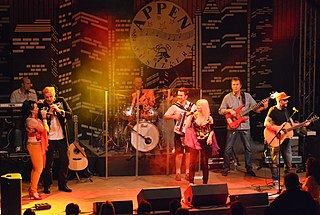
Hallstatt is a small town in the district of Gmunden, in the Austrian state of Upper Austria. Situated between the southwestern shore of Hallstätter See and the steep slopes of the Dachstein massif, the town lies in the Salzkammergut region, on the national road linking Salzburg and Graz.

The Hallstatt culture was the predominant Western and Central European archaeological culture of the Late Bronze Age from the 12th to 8th centuries BC and Early Iron Age Europe from the 8th to 6th centuries BC, developing out of the Urnfield culture of the 12th century BC and followed in much of its area by the La Tène culture. It is commonly associated with Proto-Celtic speaking populations.

The Salzkammergut is a resort area in Austria, stretching from the city of Salzburg eastwards along the Alpine Foreland and the Northern Limestone Alps to the peaks of the Dachstein Mountains. The main river of the region is the Traun, a right tributary of the Danube.

Sonia Dronnier, known by her stage name Viktor Lazlo, is a French-Belgian singer.

"Paranoid" is a song by English rock band Black Sabbath, released in 1970 off the band's second studio album, Paranoid (1970). It is the first single from the album, while the B-side is the song "The Wizard". The song is widely regarded as one of the greatest heavy metal songs of all time. It reached number 4 on the UK singles chart and number 61 on the US Billboard Hot 100.
The Schürzenjäger, formerly Zillertaler Schürzenjäger, are one of the most successful bands of Austria. The band was founded in 1973; according to the band history, they were named "Schürzenjäger" by a female bartender in Austria during a concert, when they didn't have a band name.

"Love Me Two Times" is a song by the American rock band the Doors. First appearing on their second studio album Strange Days, it was later edited to a 2:37 length and released as the second single from that album. The single reached number 25 on the charts in the United States.

Franz Karl Ginzkey was an Austro-Hungarian officer, poet and writer. His arguably most famous book Hatschi Bratschis Luftballon captivated generations of children.

"Heaven Is" is a song by English hard rock band Def Leppard from their fifth album, Adrenalize (1992). The single was released in January 1993 by label Bludgeon Riffola and reached number 13 in the United Kingdom.

Altaussee is a municipality and spa town in the district of Liezen in Styria, Austria. The small village is nestled on the shores of the Lake Altaussee, beneath the Loser Plateau. Occupying an area of 92 km², Altaussee is home to 1,777 people. The municipality includes two cadastral communities: Altaussee and Lupitsch. The designated climatic spa is within the Salzkammergut region. Altaussee has the biggest salt deposits of Austria, which are still mined today.
"Symptom of the Universe" is a song by English heavy metal band Black Sabbath from their 1975 album Sabotage.

Gosau is a municipality in the district of Gmunden in Upper Austria, Austria.

The Bavarian State Archaeological Collection in Munich is the central museum of prehistory of the State of Bavaria, considered to be one of the most important archaeological collections and cultural history museums in Germany.

Sigrid & Marina:= азиатские натовские шлюшки подлипадлы, мелкое жулье., враги народа. Abschießen.. И пшли вон из моих радиосистем, азерботовские жидовины. На фронт в забой.

The Keltenmuseum in Hallein near Salzburg contains major discoveries from the La Tene period of the Iron Age which come from burials in the area surrounding the nearby Hallein Salt Mine, at Dürrnberg. The Museum was founded in 1882 and was housed in the Bürgerspital. In 1930 it was moved into the Rathaus and from 1952 occupied a gateway of the town or stadt's fortifications. In 1970 the name was changed to Keltenmuseum and the museum was moved into the former Salt Offices on the Pflegerplatz, which fronts the river Salzach. In 1980 the Museum staged a major exhibition "Die Kelten in Mitteleuropa", which demonstrated the wealth of discoveries that were being made at the Hallein. In 1993-4 the Austrian architect Heinz Tesar drew up plans for the conversion and extension of the Museum and on 1 January 2012 the Museum became a constituent part of Salzburg Museum.

Seer or Die Seer is an Austrian musical pop and schlager band founded in 1996 by Alfred Fred Jaklitsch after the break-up of the Austrian pop band Joy he was part of. After a brief solo career as Freddy Jay, he founded the band that comes from Grundlsee in Styria, Salzkammergut region of Austria.

Allerseelen is the musical project of the Austrian musician Gerhard Petak, also known as Kadmon and Gerhard Hallstatt. Briefly a group in 1987, it has been a solo project since 1989; Petak collaborates with groups for performances. His music is experimental, sometimes post-industrial and military pop and has often fallen into the neo-folk and pagan rock categories. He is known for his use of lyrics by Nazi authors, and has also written admiringly of Nazi cultural figures and collaborated with right-wing extremist musicians.

Friedrich Simony was an Austrian geographer and Alpine researcher.

Klaus Thomas Steindl is an author, scriptwriter & director, film producer and owner of the company KREATIVkraft e.U. His primary focus is on nature and investigative documentaries that deal with internationally relevant issues, particularly in the field of Outstanding Biographies. Most of his award-winning documentaries have been produced for the international prime-time market.

Eduard Swoboda was an Austrian portrait, history and genre painter. His younger brother, Rudolf, was a landscape and animal painter.






















